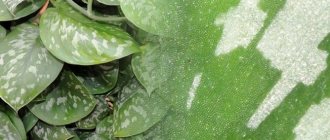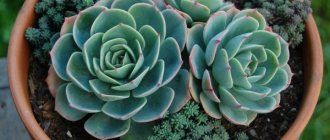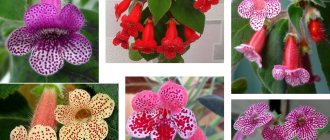Photo in the interior Having seen pedilanthus (Pedilanthus) for the first time, many people mistake it for an artificial flower. This succulent shrub from the Euphorbiaceae family (Euphorbiaceae) can grow up to 60-80 cm in height, but large plants lose their decorative value because over the years the lower part of the shoots becomes bare. Pedilanthus is a perennial; its shoots grow 15-20 cm in height per year.
Flower growers grow it as a house plant, and the homeland of pedilanthus is the subtropical and tropical regions of America. In addition to decorative leaves, the plant has interesting flowering - small flowers collected in umbrella-shaped inflorescences have a pair of bright red covering leaves. The bush should be kept out of the reach of animals, as it has a poisonous milky sap.
Be sure to read in detail about indoor spurge and jatropha.
Try growing these beautiful plants:
| Alocasia domestica |
| Spathiphyllum |
| Aglaonema - home care |
| Syngonium - care |
| Average growth rate. Shoots grow 15-20 cm in height per year. |
| Blooms in winter. |
| An easy plant to grow. Suitable even for a beginner. |
| Perennial. |
Signs and superstitions
Photo of pedilanthus in a pot
There are several signs and superstitions associated with it. For example, if you were given a pot with this plant, expect changes in the house in the near future: renovation, rearrangement or purchase of new furniture.
If you place pedilanthus in your workplace, you will receive an increase in salary and a promotion.
A plant with colored or variegated leaves is “contraindicated” for unmarried women, since she runs the risk of not meeting her spouse. This flower is also popularly called “muzhegon”.
Pedilanthus titimaloides. Photo
Features of growing at home. Briefly
When growing pedilanthus at home, you need to follow the rules of care, then it will retain the decorative appearance of its leaves and bloom regularly. Basic care requirements:
| Temperature | In summer, no hotter than 25-30˚C; in winter, avoid drafts. |
| Air humidity | High, in winter the plant is additionally sprayed and water is added to the pan. |
| Lighting | Bright light, preferably kept on a west-facing window. |
| Watering | In summer the soil should be moist, in winter it should be watered once every 5 days. |
| Priming | Fertile, containing sand and peat. Drainage is required. |
| Feeding and fertilizer | Organic is preferred. Fertilize after 3 weeks with liquid mineral fertilizer. |
| Pedilanthus transplant | In spring, if the roots have completely filled the pot. |
| Reproduction | Apical cuttings, seeds. |
| Peculiarities | Does not tolerate drafts or gas combustion products. |
Description
A characteristic feature of many species is the broken, zigzag shape of the shoots, for which local Indians called the plant “the devil’s backbone.” The shoots acquire this unusual shape due to changes in the growth of the stems with the appearance of each new leaf.
How to care for lavender in a pot at home
The most striking and popular representative of the genus in floriculture is Pedilanthus titimaloidny with a shrubby growth form and unusual flowers, which are actually bracts or modified leaves resembling a slipper in shape.
That is why the genus got its name from two Greek words: “pedilon” - shoe and “anthos” - flower, referring to the original flowering.
Large paniculate inflorescences appear at the tops of the shoots and can be red or pink. However, at home, pedilanthus does not bloom so often, and its decorative value and uniqueness lies in its spectacular foliage. The variegated varieties of "Variegata" are especially prized.
How to grow pomegranate at home
The color of the foliage, as if covered with wax, varies from golden, creamy green to pink or carmine. The leaves also differ in shape - they can be straight, concave, wavy, fleshy and glossy (Nana variety).
Caring for pedilanthus at home. Details
To preserve the decorative appearance of the foliage and activate the flowering of the plant, caring for pedilanthus at home must be appropriate. It includes a set of activities.
Bloom
Unusual inflorescences rarely appear on the shrub; it is grown mainly for its decorative foliage.
You can admire the flowering only if it has been properly cared for - it has gone through a dormant period in winter, and optimal lighting and temperature conditions have been created. Inflorescences appear in November-December, and as they wither they are cut off with scissors. After cutting the last flower, the plant is sent for wintering.
Temperature
Like all tropical plants, home pedilanthus is demanding of heat. In spring and summer, the bush is kept at a temperature of 22-26˚C. In winter, the plant should be dormant, and the temperature should be reduced to 15-17 °C, which is necessary for the formation of flower buds.
However, the pot of pedilanthus should be kept away from heating devices, otherwise the plant will shed its leaves.
To prevent the bush from being damaged during ventilation, it must first be covered or taken to another room.
Spraying
When growing a plant, you do not have to create special humidity conditions. This shrub tolerates dry apartment air well.
Spraying the crown is necessary only for leafy varieties of pedilanthus, mainly in winter, when the air is dry. The shrub is not sprayed after cuttings and pruning, which will avoid rotting of the shoots.
Lighting
It is necessary to choose a well-lit place, preferably a window sill on the south-east, south or south-west side of the house. To protect the plant from the burning direct rays of the sun, place the flower on a table near the window. In summer, it is recommended to take pedilanthus out into the open air, protecting it from sunlight and precipitation.
Don't forget about the phytolamp! This is an excellent solution for additional lighting and rapid development of the plant.
Watering
Being a tropical plant, the bush is demanding when it comes to watering.
It reacts negatively to overwatering and lack of moisture in the soil. If there is excess moisture, the roots of the plant rot, it sheds its leaves and stops blooming. In spring and summer, pedilanthus is watered regularly, moderately, monitoring soil moisture. From December to March, when the air temperature is lower, watering is reduced. For irrigation, use only filtered water at room temperature or left in a bottle for 2-3 days.
Pot
Can be grown in a ceramic or plastic pot. When choosing a container of a suitable size, you should focus on the size of the root system of the shrub. If you transplant the plant into a large pot, the soil will become sour. For young seedlings, cactus pots with drainage holes are suitable to drain excess water.
Priming
For good development, you need to plant in light, loose soil. From store-bought soils, you should choose soil for succulents to which sand is added. You can independently compose such soil from equal parts of leaf and turf soil and coarse river sand.
Be sure to add vermiculite or wet coconut substrate to prevent soil acidification.
Feeding and fertilizer
Feeding pedilanthus is necessary for its normal growth and flowering. Liquid fertilizers are applied from spring to late summer, always after watering. It is enough to feed the bush once a month with fertilizer, which contains iron, phosphorus, calcium, and there should be a minimum of nitrogen. Excess nitrogen will lead to rotting of the root system.
Choose the right fertilizer for yourself !
Transfer
Annual replanting of pedilanthus is not carried out due to the slow development of the root system. Signs that you need to replant:
- The purchased shrub needs to be replanted by changing the soil and pot.
- Roots appeared from the drainage holes of the pot.
- The roots and base of the stem rot.
The day before transplanting, water the bush. Carefully remove the flower from the pot and remove the remaining soil and rotten roots.
The roots should be washed in warm water, then left in a bright solution of potassium permanganate for 15 minutes. The dried roots are sprinkled with crushed coal and transplanted into a new pot, the bottom of which is filled with drainage. A layer of soil is poured over the drainage material and the root system is installed, filling the voids on the sides with soil. To fill the voids with soil, you need to shake the pot periodically. After watering, soil is added.
Trimming
Pruning is carried out to rejuvenate the bush and give its crown shape. On a 20 cm long stem, you need to pinch the top for branching. In spring, the tops of growing shoots are cut off by a couple of centimeters. The sections are blotted with a napkin.
If the stems have become elongated and exposed, a drastic pruning is carried out, leaving stumps 5-6 cm long. After feeding with complex fertilizer, the bush will actively begin to grow.
Rest period
During the dormant period, pedilanthus is watered once a week, the pot is kept in a room where the temperature does not exceed 15-17˚C. Feeding is excluded until spring.
Propagation of pedilanthus by cuttings
Cuttings of pedilanthus are the simplest method of obtaining young shrubs. In the spring, after pruning, the tops of the shoots remain, suitable for rooting (length 10-12 cm).
In the lower part, you need to remove the leaves, after which the cuttings are left in a container with clean warm water to stop the formation of milky juice. Wet vermiculite, sand or coconut shavings are poured into the container. The cuttings are buried 4-5 cm. The plantings should not be covered to prevent mold and rotting. The roots will appear in 3 weeks, young plants can be planted in a month.
You can root cuttings in water, to which a tablet of activated carbon and a couple of drops of a root formation stimulator are added.
Transfer
The plant has a medium-sized rhizome, proportional to the above-ground part, so the need for replanting should be guided by the volume of the crown. The width and height of the flower pot should be approximately equal to each other. Replanting should begin in the spring, when the growth of the first young leaves is noticed. Until the root system grows to the full width of the pot, there is no need to replant. During housewarming, the soil must be changed completely, as far as possible. After transplantation, the plant is left in a shaded place for at least a week for final adaptation.
It is necessary to work with gloves, as its juice is poisonous!
Diseases and pests
The following problems often arise:
- The tips of the leaves turn yellow and dry out - the reason is too dry air or hot sunlight.
- Pedilanthus leaves become small and quickly fall off - lack of light.
- Leaves fall in winter - the reason for this is draft and freezing of shoots.
Pedilanthus does not bloom - there are several reasons:
- Lack of lighting;
- The temperature regime is not observed;
- The winter dormancy period is not long enough.
- Leaves fall - during the period of active growth of the bush, the reason is a violation of the watering regime and temperature, due to a draft. In winter, you should reduce the frequency of watering and lower the temperature in the room, while maintaining maximum lighting.
- Shoots stretch out - lack of light for the plant. The shoots should be shortened and the pot moved to a more illuminated place. In winter, shoots may become thin due to warm air.
- stem and petioles of the leaves have blackened - due to the dense substrate, excessive watering, which leads to rotting of the roots.
Pests are aphids, spider mites and whiteflies.
Types of pedilanthus domestica with photos and names
Tithymaloides Pedilanthus
The stem is zigzag, thick, smooth. The dark green leaves are large, pointed, lanceolate, alternately arranged. The bush may have pink leaves or variegated leaves.
Pedilanthus largefruited or Macrocarpus (Macrocarpus)
Rare species in cultivation. The leaves are reduced to scales. In the light, straight stems turn white. The shape of the stem can be flattened and round.
Pedilanthus Nana (Nana)
The stem is thick, the dark green leaves are beautiful, opposite. The broken shape of the shoots creates a feeling of artificiality of the plant. Demanding on soil moisture and looseness.
Pedilanthus Finkii
Fleshy stems with a zigzag shape. The leaves are smooth, shiny, bright green, without a border. The bulk of the leaves are located in the upper part, the bottom is bare and requires pruning.
Pedilanthus calcaratus
Woody type of evergreen shrub. In nature, the height of the stems is up to several meters. The shoot is spiral-shaped, strewn with bright green foliage with a wavy edge. Demanding about watering and spraying.
Plant species diversity
- There are 15 species of pedilanthus, but only one is grown in indoor floriculture. Pedilanthus titimaloides - the only type for indoor floriculture.
It is a bushy plant with slipper flowers and leaves that range in color from variegated white-green to pink. The stem changes direction of growth as soon as a leaf grows on it. - Pedilanthus macrocarpus is a leafless succulent that prefers drier climates. Inhabitant of medium tropical forests and undergrowth.
- Pedilanthus large-fruited.
A succulent of an original appearance, leafless, with bare thick stems consisting of water-storing tissues - a resident of the dry tropical forest. - Pedilanthus NANA - lives in the humid tropics.
It grows as a bush and loves the proximity of tall trees and loose soils.
These three species are grown in botanical gardens and greenhouses.











